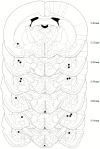Oxytocin Attenuates Yohimbine-Induced Reinstatement of Alcohol-Seeking in Female Rats via the Central Amygdala
- PMID: 37504003
- PMCID: PMC10376410
- DOI: 10.3390/bs13070556
Oxytocin Attenuates Yohimbine-Induced Reinstatement of Alcohol-Seeking in Female Rats via the Central Amygdala
Abstract
Alcohol use disorder is a significant public health concern, further exacerbated by an increased risk of relapse due to stress. In addition, factors such as biological sex may contribute to the progression of addiction, as females are especially susceptible to stress-induced relapse. While there have been many studies surrounding potential pharmacological interventions for male stress-induced ethanol reinstatement, research regarding females is scarce. Recently, the neuropeptide oxytocin has gained interest as a possible pharmacological intervention for relapse. The present study examines how oxytocin affects yohimbine-induced reinstatement of ethanol-seeking in female rats using a self-administration paradigm. Adult female rats were trained to press a lever to access ethanol in daily self-administration sessions. Rats then underwent extinction training before a yohimbine-induced reinstatement test. Rats administered with yohimbine demonstrated significantly higher lever response indicating a reinstatement of ethanol-seeking behavior. Oxytocin administration, both systemically and directly into the central amygdala, attenuated the effect of yohimbine-induced reinstatement of ethanol-seeking behavior. The findings from this study establish that oxytocin is effective at attenuating alcohol-relapse behavior mediated by the pharmacological stressor yohimbine and that this effect is modulated by the central amygdala in females. This provides valuable insight regarding oxytocin's potential therapeutic effect in female stress-induced alcohol relapse.
Keywords: alcohol; central amygdala; females; oxytocin; reinstatement; stress; yohimbine.
Conflict of interest statement
The authors report no conflict of interest and no affiliations with or involvement in any organization or entity with any financial or non-financial interest in the subject matter or materials discussed in this manuscript.
Figures




Similar articles
-
Oxytocin Attenuates the Stress-Induced Reinstatement of Alcohol-Seeking in Male Rats: Role of the Central Amygdala.Biomedicines. 2021 Dec 15;9(12):1919. doi: 10.3390/biomedicines9121919. Biomedicines. 2021. PMID: 34944734 Free PMC article.
-
Oxytocin attenuates stress-induced reinstatement of alcohol seeking behavior in male and female mice.Psychopharmacology (Berl). 2019 Sep;236(9):2613-2622. doi: 10.1007/s00213-019-05233-z. Epub 2019 Mar 28. Psychopharmacology (Berl). 2019. PMID: 30923836 Free PMC article.
-
Mifepristone in the central nucleus of the amygdala reduces yohimbine stress-induced reinstatement of ethanol-seeking.Neuropsychopharmacology. 2012 Mar;37(4):906-18. doi: 10.1038/npp.2011.268. Epub 2011 Nov 2. Neuropsychopharmacology. 2012. PMID: 22048462 Free PMC article.
-
The neuropharmacology of relapse to food seeking: methodology, main findings, and comparison with relapse to drug seeking.Prog Neurobiol. 2009 Sep;89(1):18-45. doi: 10.1016/j.pneurobio.2009.05.003. Epub 2009 Jun 2. Prog Neurobiol. 2009. PMID: 19497349 Free PMC article. Review.
-
Yohimbine as a pharmacological probe for alcohol research: a systematic review of rodent and human studies.Neuropsychopharmacology. 2022 Nov;47(12):2111-2122. doi: 10.1038/s41386-022-01363-9. Epub 2022 Jun 27. Neuropsychopharmacology. 2022. PMID: 35760866 Free PMC article.
Cited by
-
Oxytocin Reduces Noradrenergic-Induced Opioid-Like Withdrawal Symptoms in Individuals on Opioid Agonist Therapy.Biol Psychiatry Glob Open Sci. 2024 Sep 18;5(1):100395. doi: 10.1016/j.bpsgos.2024.100395. eCollection 2025 Jan. Biol Psychiatry Glob Open Sci. 2024. PMID: 39534517 Free PMC article.
References
-
- National Institute on Alcohol Abuse and Alcoholism. [(accessed on 7 June 2023)]; Available online: https://www.niaaa.nih.gov/alcohols-effects-health/alcohol-topics/alcohol...
LinkOut - more resources
Full Text Sources

